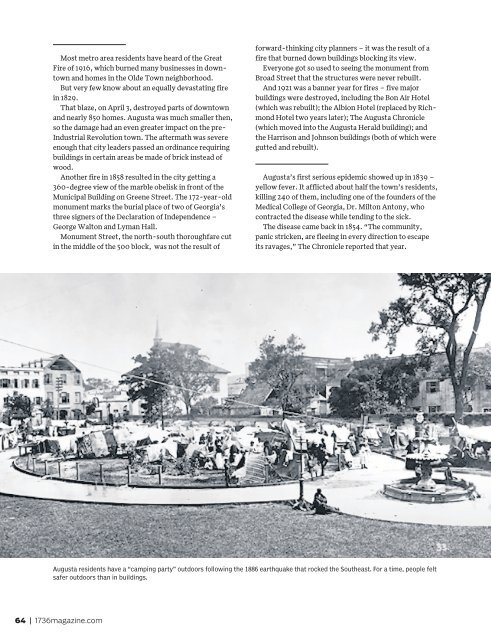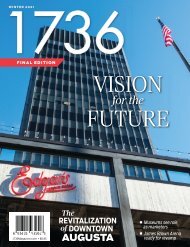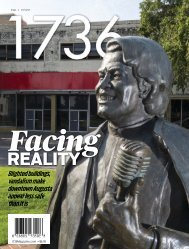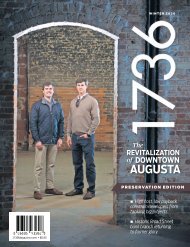Downtown business owners try to keep smiling amid pandemic - 1736 Magazine, Summer 2020
- No tags were found...
Create successful ePaper yourself
Turn your PDF publications into a flip-book with our unique Google optimized e-Paper software.
Most metro area residents have heard of the Great<br />
Fire of 1916, which burned many <strong>business</strong>es in down<strong>to</strong>wn<br />
and homes in the Olde Town neighborhood.<br />
But very few know about an equally devastating fire<br />
in 1829.<br />
That blaze, on April 3, destroyed parts of down<strong>to</strong>wn<br />
and nearly 850 homes. Augusta was much smaller then,<br />
so the damage had an even greater impact on the pre-<br />
Industrial Revolution <strong>to</strong>wn. The aftermath was severe<br />
enough that city leaders passed an ordinance requiring<br />
buildings in certain areas be made of brick instead of<br />
wood.<br />
Another fire in 1858 resulted in the city getting a<br />
360-degree view of the marble obelisk in front of the<br />
Municipal Building on Greene Street. The 172-year-old<br />
monument marks the burial place of two of Georgia’s<br />
three signers of the Declaration of Independence –<br />
George Wal<strong>to</strong>n and Lyman Hall.<br />
Monument Street, the north-south thoroughfare cut<br />
in the middle of the 500 block, was not the result of<br />
forward-thinking city planners – it was the result of a<br />
fire that burned down buildings blocking its view.<br />
Everyone got so used <strong>to</strong> seeing the monument from<br />
Broad Street that the structures were never rebuilt.<br />
And 1921 was a banner year for fires – five major<br />
buildings were destroyed, including the Bon Air Hotel<br />
(which was rebuilt); the Albion Hotel (replaced by Richmond<br />
Hotel two years later); The Augusta Chronicle<br />
(which moved in<strong>to</strong> the Augusta Herald building); and<br />
the Harrison and Johnson buildings (both of which were<br />
gutted and rebuilt).<br />
Augusta’s first serious epidemic showed up in 1839 –<br />
yellow fever. It afflicted about half the <strong>to</strong>wn’s residents,<br />
killing 240 of them, including one of the founders of the<br />
Medical College of Georgia, Dr. Mil<strong>to</strong>n An<strong>to</strong>ny, who<br />
contracted the disease while tending <strong>to</strong> the sick.<br />
The disease came back in 1854. “The community,<br />
panic stricken, are fleeing in every direction <strong>to</strong> escape<br />
its ravages,” The Chronicle reported that year.<br />
Augusta residents have a “camping party” outdoors following the 1886 earthquake that rocked the Southeast. For a time, people felt<br />
safer outdoors than in buildings.<br />
64 | <strong>1736</strong>magazine.com
















